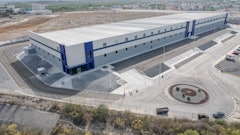Taking place between November 25 and 28, 2014, in Shanghai is bauma China, the International Trade Fair for Construction Machinery, Building Material Machines, Construction Vehicles and Equipment. Although currently challenging, the market in China still offers significant potential, not least because the state is investing heavily in infrastructure – and this is just one of the drivers behind an acceleration in growth in the Chinese construction sector.
In the first six months of 2013 the equivalent of €160 billion (RMB 1,346 billion) was invested in China in civil engineering and infrastructure projects. According to the National Bureau of Statistics of China this was an increase of over 21% as compared to the same period in the previous year.
The biggest part of this money went into road building. Bernd Schaaf of Germany Trade & Invest (GTAI), Germany’s economic development agency, reports that "the activities here are increasingly concentrating in the west of the country." That is precisely in line with the Chinese government’s long-term planning: the aim is to promote economic growth in the hinterland, too, away from the already booming coastal region in the east, in order to reduce the wide disparities between the urban and rural communities. "Huge investment in transport and infrastructure is needed if this is to be achieved," points out Schaaf.
According to the current Five Year Plan (2011 to 2015) up to 65,000 km of new roads are to be built in China by the year 2015. Added to this, in the same period, are 30,000 km of new railway tracks around the country with an accumulated investment volume of RMB 2.8 trillion. Building new airports is also on the agenda: GTAI’s current economic report (dated October 2013) reveals that investment here in the first six months of 2013 has risen in comparison to the same period in 2012 by almost 27%, to RMB 53 billion.
Despite all these major construction projects, the Chinese construction machinery market is not an easy one, as Sebastian Popp, responsible for the construction equipment and building material machinery section at the VDMA, Germany’s engineering federation, explains. "Up until 2011 the country was experiencing a building boom, as the construction sector of the economy was overheating." Almost all Chinese construction machinery manufacturers reacted to this with a significant expansion of their capacities. Popp continues, "As a result of central government’s measures to cool down the building sector, demand for construction machinery fell sharply in 2012. Now the situation is one of significant overcapacities and enormous fleets of recently produced machinery in the market."
For the international manufacturers who are producing in China, overcapacity, according to the VDMA expert, is generally not such a problem. The bigger challenge, he believes, lies in resisting over-engineering. "In an ever more competitive market, it’s all the more important to deliver machinery and plant that is attuned to Chinese demand."
Opportunities in this market can be found in particular in high-spec infrastructure projects, says the GTAI expert Schaaf. "For example, in the shape of tunnel-driving machines for above-ground and underground railway construction and special machinery for mining, building construction and civil engineering."
New technologies and machinery in these areas will be presented by the exhibitors at bauma China 2014. Once again, this event will be the sector’s most important event in the year for the whole of Asia. It will take up the entire space, i.e. 300,000 square meters, at the Shanghai New International Expo Centre.
Investment in China's transport infrastructure continues to grow
Investment in China's transport infrastructure increased 21% in the first six months of 2013, and will continue to grow.
December 5, 2013



























